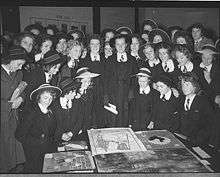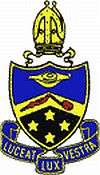SCEGGS Darlinghurst
| SCEGGS Darlinghurst | |
|---|---|
|
| |
| Location | |
|
Darlinghurst, New South Wales Australia | |
| Coordinates | 33°52′33″S 151°13′6″E / 33.87583°S 151.21833°ECoordinates: 33°52′33″S 151°13′6″E / 33.87583°S 151.21833°E |
| Information | |
| Type | Independent, Single-sex, Day and Boarding |
| Denomination | Anglican |
| Established | 1895 |
| Founder | Edith Badham |
| Chairman | Sharon Cook |
| Principal | Jenny Allum |
| Staff | ~120[1] |
| Enrolment | ~890 (K–12)[1] |
| Colour(s) | Navy Blue and White |
| Website | www.sceggs.nsw.edu.au |

SCEGGS Darlinghurst is an independent, Anglican school for girls, located in Darlinghurst, an inner-city, eastern suburb of Sydney, New South Wales, Australia.
Founded in 1895, as the Sydney Church of England Girls Grammar School, the school's official name was replaced with SCEGGS Darlinghurst in 1995. The school has a non-selective enrolment policy and currently caters for approximately 890 students from Kindergarten to Year 12. The school is regularly amongst the top-performing schools in New South Wales.[1] Whilst predominantly a day school, SCEGGS offers a small number of boarding places at St Vincent's College, Potts Point.
SCEGGS is affiliated with the Association of Heads of Independent Schools of Australia (AHISA),[2] the Junior School Heads Association of Australia (JSHAA),[3] the Alliance of Girls' Schools Australasia (AGSA),[4] and is a founding member of the Association of Heads of Independent Girls' Schools (AHIGS).[5]
In 2001, The Sun-Herald ranked SCEGGS Darlinghurst second in Australia's top ten girls' schools, based on the number of its alumni mentioned in the Who's Who in Australia (a listing of notable Australians).[6][a]
History
On 17 July 1895, a Grammar School for Girls was officially opened in Sydney under the auspices of the Sydney Diocese of the Church of England. The Sydney Church of England Girls' Grammar School (or S.C.E.G.G.S.) commenced in a terrace house at 65 (now 55) Victoria Street, Darlinghurst with one pupil, Mary Watson, one teacher, Miss Janet Uther, and the Principal, Miss Edith Badham. Within a year, the school had increased to 50 pupils enrolled, and moved to "Chatsworth", a larger home in Macleay Street.[7]
By 1900, the school had 100 pupils, including a Kindergarten and junior school. "Barham" in Forbes Street, Darlinghurst was purchased and the school moved there in 1901. The curriculum at the time included English Language and Literature, Geography, Modern and Ancient History, Latin, Classical Greek, Mathematics, French Language and Literature, German or Italian, Needlework and Drilling. Classes in Botany, Geology or other scientific subjects, were also offered to pupils who reached a fair standard of proficiency in their ordinary subjects. Classes in Cookery and Dressmaking were held whenever there was sufficient demand.[7]
S.C.E.G.G.S. continued to expand and several Branch Schools were opened - Bowral (1906–1929) relocating to Moss Vale (1930–1974), Hunters Hill (1912–1915), North Sydney (1911–1941) becoming Redlands (1945–1976), Wollongong (1955–1976) and Loquat Valley (1967–1976).[7]
In 1974, financial difficulties arose due to the controller of the Anglican diocesan schools misappropriating school funds, threatening the school with closure. Within two years, contributions from the school community and the Sydney Diocese ensured that the original school, S.C.E.G.G.S. Darlinghurst, was not closed but continued to operate. Moss Vale was forced to close in 1974, and two years later, Redlands, Wollongong and Loquat Valley became schools independent from S.C.E.G.G.S. Darlinghurst, and have been governed by their own boards ever since.[7]
A company, S.C.E.G.G.S. Darlinghurst Ltd, was formed in 1976, under a Board of Directors, to govern the school. On the school's Centenary in 1995, the school name was changed from Sydney Church of England Girls' Grammar School, Darlinghurst (S.C.E.G.G.S.) to SCEGGS Darlinghurst.[7]
Principals
| Period | Details[5] |
|---|---|
| 1895 – 1920 | Miss Edith Badham |
| 1920 – 1947 | Miss Dorothy Wilkinson |
| 1947 – 1977 | Miss Barbara Chisholm |
| 1978 – 1995 | Miss Diana Bowman |
| 1996 – Current | Ms Jenny Allum |
Campus
SCEGGS Darlinghurst has expanded from a terrace house in 1895 to a campus incorporating a chapel, primary school, classroom blocks, assembly hall, science and library block, auditorium, sports hall, senior study building, Lechture Theature, Play house, Great Hall and performing arts centre and many more. From 1965 to 1983, a preparatory school was operated at Bellevue Hill for boys and girls up to Kindergarten age.[7] A new music centre has also been added, including a renovated church to be used for performances etc.
House system
The house system was introduced in 1926 by Miss Wilkinson to help generate school spirit and sporting enthusiasm,encourage good conduct and to provide girls with opportunities for taking on responsibility. House competitions are held in various sports, in music, drama, science and debating.
- Badham
Named after Miss Edith Badham, first Headmistress (1895–1920) and founder and first President of the Old Girl's Union. Colours: Red and Gold.
- Barton
Named after Sir Edmund Barton, first Prime Minister of Australia (1901–1903), Justice of the High Court (1903–1920) and father of Jean "Muffie" Barton, pupil 1895-1899. Colours: Red and White.
- Beck
Named after Rev Canon Ernest Beck, member of the School Council (1895–1906) and second school chaplain (1901–1928), . Colours: Blue and Gold.
- Christian
Named after Mrs Lydia Christian, Member of the School Council(1897–1919) and mother of Lilian Mary Christian, pupil 1895-1896. Colours: Red and Black.
- Docker
Named after Mr Wilfred Law Docker, first treasurer of the School Council (1895–1919). Colours: Blue and Black.
- Langley
Named after Archbishop John Douse Langley, first Secretary of the School Council (1894–1927) and Bishop of Bendigo (1907–1919). Colours: Green and Gold.
Notable alumnae
- Media, entertainment and the arts
- Gillian Armstrong - Film director
- Blanche d'Alpuget - biographer; Bob Hawke's 2nd wife
- Anne Davies - Sydney Morning Herald journalist and MEAA identity
- Tania Davis - Musician
- Ursula Dubosarsky - Author
- Susanne Gervay - Author
- Claudia Karvan - Actress
- Julie McCrossin - MC/Comedian
- Pamela Stephenson - comedian, therapist and wife to actor Billy Connolly
- Sally Bowrey - TV Presenter / Producer
- Celina Edmonds - TV News presenter
- Sarah Wynter - Actor
- Medicine and science
- Dr Elizabeth Elliott AM[8] - Professor of Paediatrics, Sydney University[9]
- Dr Joan Freeman - Nuclear Physicist, Rutherford Medal and Prize winner
- Vera Ramaciotti - philanthropist (established the Clive and Vera Ramaciotti Foundation for biomedical research)
- Politics, public service and the law
- Virginia Bell - a Puisne Justice of the High Court of Australia, since 2009
- Dr Liz Kernohan - Liberal politician
- Kay Patterson - Liberal senator and former Health Minister
- Esme Tombleson (1917–2010), Member of Parliament in New Zealand, and multiple sclerosis advocate[10]
- Margaret Whitlam AO (née Dovey) - champion swimmer, social worker, wife of the 21st Prime Minister of Australia, Gough Whitlam, and a former Australian National Living Treasure[11]
- Olive Kelso King, World War I ambulance driver
- Sport
- Samantha Marshall - swimmer, Commonwealth Games silver medallist and Malcolm Fraser's granddaughter [12][13]
See also
Notes
- ^ Who's Who of girls' school rankings: 1.Loreto Kirribilli, 2.SCEGGS Darlinghurst, 3.MLC Melbourne, 4.PLC Sydney, 5.Melbourne Girls Grammar School, 6.Mac.Robertson Girls' High School, 7.North Sydney Girls High School, 8.Sydney Girls High School, 9.MLC Sydney, 10.University High School, Melbourne
References
- 1 2 3 "SCEGGS Darlinghurst Annual Report 2007" (PDF). Front Pages. SCEGGS Darlinghurst. 2008. Archived from the original (PDF) on 2008-07-19. Retrieved 2008-05-22.
- ↑ "AHISA Schools". New South Wales. Association of Heads of Independent Schools of Australia. November 2007. Archived from the original on 2007-11-02. Retrieved 2007-12-12.
- ↑ "JSHAA New South Wales Directory of Members". New South Wales Branch. Junior School Heads' Association of Australia. 2007. Retrieved 2007-12-12.
- ↑ "Member Schools". Members. The Alliance of Girls Schools Australasia. 2007. Retrieved 2007-12-12.
- 1 2 "Heads of New South Wales Independent Girls' Schools". About AHIGS. Association of Heads of Independent Girls Schools. Retrieved 2007-12-02.
- ↑ Walker, Frank (2001-07-22). "The ties that bind". Sunday Life. The Sun-Herald. p. 16. Retrieved 2007-09-12.
- 1 2 3 4 5 6 Matthews, Linda (2007-03-12). "The History of SCEGGS". General Information. SCEGGS Darlinghurst. Archived from the original on 2008-07-19. Retrieved 2008-03-16.
- ↑ "Keynote Speakers". APSAD Conference 2010. Retrieved 3 December 2010.
- ↑ "Professor Elizabeth Elliot". Sydney Medical School. Retrieved 3 December 2010.
- ↑ Gustafson, Barry (1986). The First 50 Years : A History of the New Zealand National Party. Auckland: Reed Methuen. p. 348. ISBN 0-474-00177-6.
- ↑ "Margaret Whitlam defined being a PM's wife". The Sydney Morning Herald. AAP. 17 March 2012. Retrieved 17 March 2012.
- ↑ Bordermail.com.au
- ↑ Theaustralian.com.au
